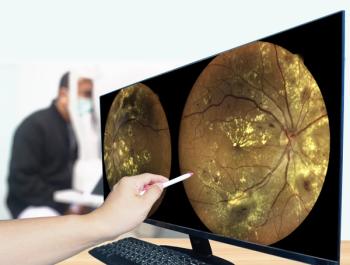
Risk factors and recommendations for DR, DME
According to a
The
Specifically, the report noted ethnicity, family history of diabetes, and previous gestational diabetes combined with older age, weight, unhealthy diet, physical inactivity, and smoking increases the risk. The AOA notes that specific risk factors for type 1 diabetes are unclear, but family history, viral exposure (e.g., Epstein-Barr virus), or autoimmune disorders may play a role.4
Furthermore, based on cost estimates from a recent systematic review, it has been estimated that the direct annual cost of diabetes to the world is more than US$827 billion.3 The
Both the
In Table 1, the AOA summarized the estimated proportion of people with DR and DME by type and diabetes duration. The prevalence of people with diabetes (diagnosed or undiagnosed) is around 27% in people 65 years or older, 10% of non-Hispanic whites older than 20 years of age, and 19% of non-Hispanic blacks older than 20 years of age.
Because there is an acute onset of symptoms for people with type 1 (typically following hyperglycemia), clinical testing for antibodies related to type 1 is not recommended as a means to identify people at risk; the ADA does recommend that all people over the age of 45 be screened, however.
References:
1. Diabetic Retinopathy. Available at: https://www.aoa.org/patients-and-public/eye-and-vision-problems/glossary-of-eye-and-vision-conditions/diabetic-retinopathy Accessed October 15, 2019. St. Louis, MO: American Optometric Association, 2019.
2. World Health Organization. Diabetes Fact Sheet. https://www.who.int/news-room/fact-sheets/detail/diabetes. Accessed October 26, 2019. Geneva, Switzerland: WHO, 2019.
3. World Health Organization. Global Report on Diabetes. Geneva, Switzerland: WHO, 2016.
4. American Optometric Association. Eye Care of the Patient with Diabetes Mellitus: Evidence-Based Clinical Practice Guideline. Optometric Clinical Practice Guideline. Available from: http://www.aoa.org/Documents/EBO/EyeCareOfThePatientWithDiabetesMellitus%20CPG3.pdf. Accessed October 15, 2019. St. Louis, MO: American Optometric Association, 2014.
5. Prevent Blindness America. Vision Problems in the U.S. Prevalence of Adult Vision Impairment and Age-Related Eye Disease in America. Accessed June 20, 2012. Chicago, IL: Prevent Blindness, 2012.
6. Harris MI, Klein R, Welborn TA, Knuiman MW. Onset of NIDDM occurs at least 4-7 yr before clinical diagnosis. Diabetes Care 1992;15(7):815-9.
7. Kohner EM, Aldington SJ, Stratton IM, et al. United Kingdom Prospective Diabetes Study, 30: diabetic retinopathy at diagnosis of non-insulin-dependent diabetes mellitus and associated risk factors. Arch Ophthalmol 1998;116(3):297-303.
8. American Diabetes Association. Executive summary: Standards of medical care in diabetes--2013. Diabetes Care 2013;36 Suppl 1:S4-10.
9. American Academy of Ophthalmology Retina Panel. Preferred Practice Pattern Guidelines: Diabetic Retinopathy. San Francisco, CA: 2016.
10. Yung CW, Boyer MM, Marrero DG, Gavin TC. Patterns of diabetic eye care by primary care physicians in the state of Indiana. Ophthalmic Epidemiol 1995;2(2):85-91.
11. Ozerov I, Monderer R. Diabetic retinopathy: Examination and referral practices of primary care providers. Einstein Quart J Biol Med 2001;18:164-70.
Newsletter
Keep your retina practice on the forefront—subscribe for expert analysis and emerging trends in retinal disease management.







































